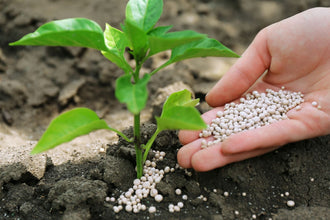Organic fertilizers, derived from natural sources, are fundamental to sustainable gardening and agricultural practices, serving to slowly release nutrients and improve soil health. Amidst this natural spectrum, urea emerges as a core fertilizer, favored for its nitrogen richness.
However, its synthetic production, a process involving industrial combination of ammonia and carbon dioxide, ignites a debate: Does urea qualify as an organic amendment? This article delves into the intricate relationship between urea's high-efficiency nutrient delivery and the ethos of organic fertilization.
What is Urea?
Urea, often hailed as a cornerstone in the world of fertilizers, plays a crucial role in modern agriculture and gardening due to its rich nitrogen content. Its journey from a simple organic compound to a staple in nutrient delivery mechanisms is both fascinating and multifaceted. Here, we dive deeper into the chemical essence of urea and the process behind its production.
Chemical Composition and Properties
- Formula: Urea's chemical formula is CO(NH2)2, making it a diamide of carbonic acid.
- Nitrogen Content: It boasts one of the highest nitrogen contents among solid nitrogenous fertilizers available commercially, with a composition of approximately 46% nitrogen by weight.
- Solubility: Urea is highly soluble in water, which makes it an excellent choice for various application methods, including foliar sprays and irrigation systems.
- Stability: In its pure state, urea is relatively stable and non-volatile, lending itself well to storage and handling.
How Urea is Produced
- Synthetic Production: Unlike many organic fertilizers derived directly from plant or animal matter, urea is synthesized through an industrial process. The most common method, known as the Haber-Bosch process, combines ammonia and carbon dioxide under high pressure and temperature to form urea and water.
- Historical Context: This method of urea synthesis was first developed in the early 20th century and has since revolutionized agricultural practices by making nitrogen, an essential nutrient for plant growth, readily available in a concentrated and easy-to-apply form.
- Environmental Impact: While the production of urea is energy-intensive, recent advancements in technology have focused on making the process more efficient and environmentally friendly, reducing the carbon footprint associated with its manufacture.
Advantages of Using Urea as a Fertilizer
The agricultural landscape is dotted with choices for fertilization, each with its own set of benefits and considerations. Urea stands out among its peers not just for its chemical properties but also for the versatility and efficiency it brings to fields and farms.
High Nitrogen Content and Its Importance
Urea is highly prized in agriculture due to its high nitrogen content of around 46%, which significantly boosts growth, yield, and overall crop health. As nitrogen is a mobile and easily depleted nutrient in the soil, urea's ability to replenish it makes the fertilizer vital for supporting extensive crop growth periods and yielding robust harvests.
The Efficiency of Urea for Various Crops
Urea stands out as a versatile fertilizer, efficiently catering to the diverse nutritional demands of various crops, from wheat and rice to cotton and maize. Thanks to its water solubility and ease of dispersal, urea ensures the ready availability and optimal uptake of nitrogen, making it a key player in maximizing crop yields, particularly in intensive farming operations.
Additional Benefits and Considerations
- Cost-Effectiveness: Urea generally offers a more cost-effective solution for nitrogen supplementation compared to other fertilizers, providing a high concentration of nitrogen per dollar spent.
- Ease of Handling and Application: Its granular form facilitates easy handling, transport, and application, making it a preferred choice for both small-scale gardeners and large-scale agricultural producers.
- Lower Soil Acidification: Compared to some other nitrogenous fertilizers, urea tends to have a lesser acidifying effect on soil, which can help in maintaining soil health over time.
- Flexibility in Usage: Urea can be applied before sowing, as a top-dress, or as a foliar spray, offering flexibility based on crop stage and specific nutritional needs.
These benefits, coupled with its practical advantages in terms of cost, handling, and application, solidify urea's place as a cornerstone of modern agricultural fertilization strategies.
How Urea Works in Soil
Understanding the dynamics of urea in soil is essential for leveraging its full potential as a fertilizer. What makes urea remarkably efficient is its breakdown process, which ensures the availability of nitrogen for plant uptake.
The Breakdown Process of Urea in the Soil
Once applied, urea doesn't linger in its original form for long. Its transformation begins when it encounters the enzyme urease, naturally found in soils. This interaction results in the conversion of urea into ammonia gas and carbon dioxide, a process known as hydrolysis.
The ammonia can quickly volatilize, becoming lost to the atmosphere if not converted into a plant-accessible form. Fortunately, soil bacteria convert most of the ammonia to ammonium, a form of nitrogen that readily binds with soil particles and is accessible to plants.
Factors Affecting Urea's Efficacy as a Fertilizer
Urea's effectiveness isn't universal; various conditions can influence its performance. Factors such as soil pH, temperature, moisture levels, and the presence of urease and nitrifying bacteria can impact the breakdown of urea and its eventual assimilation by plants.
For instance, a warmer, more moist soil condition can expedite urea hydrolysis. On the other hand,soil acidity can affect the speed and efficiency of the conversion of ammonia to ammonium.
Urea Application Tips for Best Results
To maximize the benefits of urea and minimize potential issues, consider the following guidelines regarding dosage, timing, and the influence of environmental factors.
Dosage and Timing for Applying Urea
- Accurately calculate urea dosage based on the specific crop requirements and pre-existing soil nitrogen levels to prevent over-fertilization.
- The timing of urea application is crucial to maximize uptake and minimize losses. Applying urea when the crops are actively growing and can readily utilize the nitrogen ensures efficiency. Early morning or late afternoon applications, preferably just before a light rain or irrigation, can also reduce nitrogen volatilization.
The Role of Weather and Soil Conditions
- Humidity and temperature significantly affect urea's efficacy. Cooler, moist conditions favor urea application because they slow down the volatilization process, allowing more urea to be converted into a usable form for plants.
- Soil type and pH also play critical roles. Loamy and clay soils with neutral pH are ideal for urea application, ensuring better ammonia retention.
Potential Downsides of Urea
While urea is highly beneficial, it's not without its challenges. Awareness of these can help in developing strategies to mitigate any negative effects.
Volatilization and Other Concerns
The primary downside of urea application is the risk of nitrogen loss through volatilization. The nitrogen escapes as ammonia gas into the atmosphere before it can be utilized by plants.
Over-application can lead to excessive vegetative growth at the expense of fruit or seed development. It may also contaminate water sources through leaching and runoff.
Mitigating Environmental Impacts
- Incorporate Urea into the Soil: This reduces the exposure of urea to the air, significantly decreasing volatilization losses.
- Use of Urease Inhibitors: These chemicals slow down the hydrolysis of urea, extending the time for urea conversion to ammonium and its incorporation into the soil.
- Monitoring and Adjusting Application Based on Environmental Conditions: Adjust urea application strategies based on current weather conditions and soil moisture levels to optimize nitrogen use efficiency and minimize losses.
Achieving the best outcomes with urea requires a balanced approach that considers the specific needs of crops, local soil and weather conditions, and environmental sustainability. By adhering to recommended practices for dosage, timing, and mitigating strategies, urea can effectively support agricultural productivity while minimizing its ecological footprint.
Conclusion
The debate on whether urea can be classified as an organic fertilizer pivots around its mode of production and source. While naturally occurring urea is indisputably organic, synthetically produced urea's qualification varies. What is important for gardeners and farmers is understanding the impacts and benefits of urea on their soil and plants.
To ensure you're giving your plants the best, consider trying Fancy Chicken's pelletized organic chicken manure fertilizers. These fertilizers are not only approved for organic agriculture but also promote healthy growth and enrich soils with essential nutrients. Click the link to explore Fancy Chicken solutions and transform the way you nurture your garden today.








